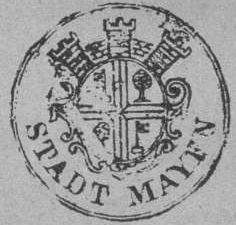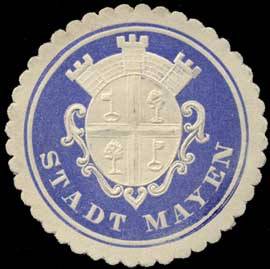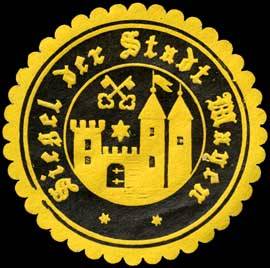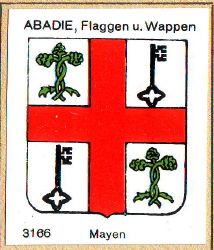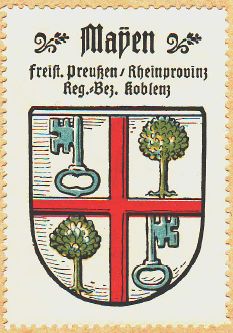Mayen: Difference between revisions
Knorrepoes (talk | contribs) m (Text replacement - "{{de}}" to "") |
Knorrepoes (talk | contribs) m (Text replacement - "|'''English''' ↵| {{blazon wanted}}" to "|'''English''' | blazon wanted") |
||
| Line 16: | Line 16: | ||
|- | |- | ||
|'''English''' | |'''English''' | ||
| | | blazon wanted | ||
|} | |} | ||
Revision as of 05:38, 8 April 2023
MAYEN
State : Rheinland-Pfalz
District (Kreis) : Mayen-Koblenz (until 1970 Mayen)
Additions : 1970 Alzheim (1969 Allenz, Berresheim), Hausen bei Mayen, Kürrenberg, Nitztal (1967 Kürrenberg, Sankt Johann-Nitz)
| German | In Silber ein durchgehendes, facettiertes, rotes Balkenkreuz, oben rechts und unten links begleitet mit einem linksgewendeten roten Schlüssel, oben links und unten rechts mit einem fünfblättrigen grünen Baum (Maibaum-Buche), jeweils den Querbalken teilweise belegend. |
| English | blazon wanted |
Origin/meaning
Mayen got city rights in 1291, and the oldest seal of the city dates from the same year. It shows a castle below two crossed keys. The keys symbolise the fact that the city belonged to the State of Trier. The patron saint of Trier is St. Peter, whose symbol is a key or, as it is often displayed, two crossed keys. Later seals show the same composition.
The first seal showing a different composition dates from 1429, and shows a cross, with in each corner a key. The present arms are based on this seal. The trees are so-called May-trees (or freedom-trees), which are a canting symbol (Mai-baum, or Maie).
Hupp showed the arms in the 1920s in a different composition:
| The municipal stamp shown in 1892 |
Seal from around 1900 with the arms |
| Seal from around 1900 with the composition of the old seal |
The arms in the Abadie albums |
| The arms by Hupp in the Kaffee Hag albums +/- 1925 |
Literature: Stadler, 1964-1971, 8 volumes

